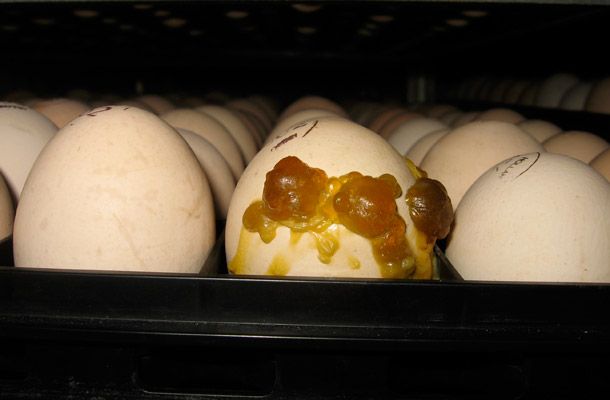Dealing with exploders
Tags: Hatchery management | Whitepaper
, November 11 2010

Hatchery employees, especially when involved in transferring eggs from setter to hatcher, are occasionally confronted with so called ‘bangers’ or ‘exploders’. A loud bang, followed by a very bad smell, are the usual signs. This phenomenon is caused by gas producing bacteria, often Pseudomonas spp., inside the egg.
Pressure inside such an egg builds up and even a small vibration can be enough to trigger the explosion. During the second half of incubation, this also occurs without human involvement within the setter; empty places in the setter tray and pieces of shell and rotten egg contents on the floor or other eggs are the visible signs. The gas can also press a foamy yellowish substance through the pores of the egg - which makes a potential exploder easy to recognize. Exploding eggs lead to heavy bacterial contamination, putting the hatchery’s hygiene status at risk, with negative effects on hatchability, chick quality and subsequent performance.
Eggs are not laid in a sterile environment. Even a visually clean egg has 1,000 to 10,000 bacteria on its surface. This does not naturally cause a problem, as eggs are very well protected against bacterial penetration. However sometimes the egg’s defence mechanism is breached, as in the case of eggs produced in wet floor or nest litter. These eggs can later be potential exploders, because directly after laying the cuticle does not offer full protection and bacteria counts are high in these conditions. Moreover the shrinkage of its contents as an egg cools down to environmental temperature will suck bacteria deep into the pores. Water on the shell also facilitates bacterial penetration, which is why it is important to avoid condensation on the egg shell, commonly called ‘sweating’, which can occur if cold eggs are suddenly exposed to a higher temperature.
When flocks age, the cuticle becomes thinner and the shells weaker, with an increased risk of hairline cracks, which allows bacteria easy access to the egg’s interior. The natural antimicrobial compound lysozyme, together with the bacteria-unfriendly alkaline environment of the albumen, prevents rapid bacterial multiplication. This may even kill all bacteria, if there are not too many. But once the eggs are exposed to incubation temperature, this defence mechanism no longer offers protection. The combination of incubation temperatures and the ready supply of nutrients in the egg will cause the number of bacteria to increase exponentially.
To completely eradicate exploders may not be achievable, but by good management their number can be kept to an acceptable minimum and the negative consequences of an incidental exploder can be controlled.
Advice
- Do not set floor eggs, dirty eggs and eggs with hairline cracks, as these are potential exploders.
- Only set floor or dirty eggs if the disadvantages of setting these eggs are fully understood and accepted, in which case they should be placed on the lowest trays.
- Transfer eggs from older flocks after the eggs of young flocks have been transferred, to avoid cross contamination.
- During candling or transfer, remove potential exploders manually and dispose of them either in a bucket with disinfecting fluid or by a vacuum system.
- Clean up the mess after an exploder immediately with a new, clean paper tissue, followed by wiping the area with a cloth soaked in an appropriate disinfectant.
- Consider disinfecting infected batches after transfer with an appropriate disinfectant.
- Plan chick take-off and further handling of infected batches at the end of the day.
- Intensify hygienic procedures, including cleaning and disinfection of the hatchery and all equipment that comes in direct contact with eggs and chicks to reduce the spread of bacteria.